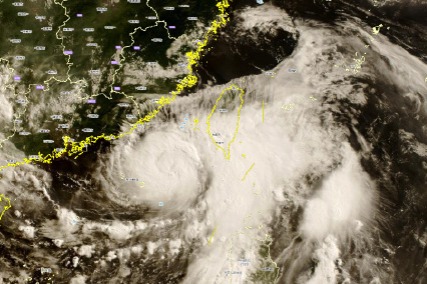Philippines Tourism Faces Disruptions as Typhoon Danas Approaches PAR, Affecting Popular Destinations: Here's All Travelers Need to Know In This Vital Situation - Travel And Tour World
Sunday, July 6, 2025

The Philippine tourism industry, an industry which had always rebounded in the past years, is in for a major disruption as Typhoon Danas, originally Bising, hovers over the Philippine Area of Responsibility (PAR). The Philippine Atmospheric, Geophysical, and Astronomical Services Administration (PAGASA) issued a tropical cyclone advisory for the entire nation early Sunday when it alerted that the typhoon, increasing in power as it moves through the Batanes seaboard, was due to move back into the PAR late Sunday or early Monday. With its top sustained winds at 120 km/h and gustiness at 150 km/h in its most severe points, the regional menace brought upon us by Danas is dire and covers multiple areas with multiple being major tourist attractions.
For foreign and domestic tourists headed to the Philippines within the coming few days, Typhoon Danas offers a lesson in the rapid disruption of travel schedules that weather can cause. As one of the most powerful storms to hit the area this year, its impacts are far-reaching and long-lasting and have the potential to affect foreign and domestic tourists alike. From foiled trips and delayed aircraft to possible disruption in coastal and rural areas, travelers and tourism businesses will have to prepare for the worst.
Typhoon Danas is expected to move north-northeastward toward the northern Philippines. Its first impact will likely be felt on the island of Batanes, where the typhoon’s outer bands are already bringing heavy rain and strong winds. For visitors to Batanes, this could mean more than just a brief inconvenience. The region is known for its picturesque landscapes, including the iconic rolling hills and stunning coastal views, but those scenic spots could soon be battered by the storm.
Batanes, one of the northernmost provinces of the Philippines, is a popular destination for travelers seeking solitude and natural beauty, far removed from the crowded beaches of the more popular destinations like Boracay or Palawan. However, with the arrival of Typhoon Danas, tourism in this area may be put on hold, as local authorities issue safety advisories and businesses temporarily close to protect tourists and residents.
In addition to Batanes, other northern provinces, such as Cagayan Valley and parts of Ilocos Norte, may also experience heavy rains and strong winds. This will lead to temporary closures of businesses and tourist spots, especially in areas with limited infrastructure. Local transport in these provinces could be significantly disrupted, with ferries and flights potentially grounded or delayed due to the storm.
Metro Manila, the Philippines’ bustling capital, could also see significant disruptions due to the typhoon’s influence. As Danas moves north, it is expected to bring heavy rainfall to the region, which could lead to flooding in low-lying areas. Flooding in areas like Pasig, Quezon City, and Manila itself could cause road closures, making it difficult for tourists to navigate the city. Popular tourist attractions such as Intramuros, Rizal Park, and the National Museum could be temporarily inaccessible if heavy rains and floods make it unsafe for visitors to travel.
While the primary impact of Typhoon Danas is expected to be in the north, its effects will be felt across the entire archipelago. For tourists looking to enjoy outdoor activities such as surfing in Siargao, hiking in the Cordilleras, or diving in Palawan, the storm will pose a serious challenge. Coastal areas, in particular, will face the risk of rip currents and high waves, which could make swimming, diving, and other water activities hazardous. As Typhoon Danas strengthens and heads further north, coastal resorts and adventure tour operators may be forced to cancel or reschedule activities to ensure the safety of guests.
Even if the storm weakens in the coming days, the damage to the tourism sector could linger long after it has passed. Coastal communities, popular diving spots, and eco-tourism destinations that rely on the influx of tourists could see a drop in business, as cancellations increase and travelers opt to avoid affected areas.
The Philippine tourism industry, which was on the road to recovery after the pandemic, will undoubtedly feel the economic impact of Typhoon Danas. For many local businesses—especially those in the hospitality sector—the storm could lead to short-term losses. Hotels, resorts, and guesthouses in the affected areas may have to offer refunds or reschedule bookings for travelers unable to visit due to the weather. This can result in a temporary loss of income for businesses already grappling with fluctuating demand.
Local tour operators, who depend on a steady stream of visitors to support their businesses, will also face challenges. For operators in provinces like Batanes and Cagayan Valley, the storm’s interruption could significantly reduce revenue during what was expected to be a peak tourism season. A slow recovery from the storm could further strain these small businesses, which may need to adjust their operating models in the aftermath of the typhoon.
Additionally, Typhoon Danas could affect local economies that rely heavily on tourism. From food vendors and souvenir shops to transportation services and regional markets, the ripple effects of the storm could hinder the ability of local economies to bounce back quickly. The disruption caused by this typhoon is a stark reminder of how unpredictable weather events can damage the delicate balance of regional tourism.
For those planning to visit the Philippines in the coming days, staying informed is crucial. PAGASA has advised residents and tourists in the affected regions to be on alert and follow safety advisories issued by local government units. Tourists should monitor official weather updates and consider postponing travel plans if they are headed toward northern provinces.
Travelers should also prepare for the possibility of cancellations or delays in flights, ferries, and other forms of transportation. Many major airlines operating in the Philippines, such as Philippine Airlines and Cebu Pacific, have contingency plans in place to help customers rebook flights or issue refunds in the event of weather-related cancellations. It is advisable for tourists to keep their travel plans flexible, especially if they are headed to areas under storm warning.
For those already in the Philippines, it is important to secure accommodations that are safe and able to withstand the storm. Tourists should be aware of evacuation procedures and emergency contact numbers, which can be found through local authorities or their accommodation providers. Staying in close contact with local tour operators can also help ensure that plans are adjusted according to the storm’s movement.
Once Typhoon Danas passes, the focus will shift toward recovery and rebuilding efforts. It is expected that regions affected by the storm will need time to recover, with the potential for some areas to remain inaccessible for a few days due to flooding or road damage. For tourists hoping to continue their vacations, checking local updates on the reopening of attractions and businesses will be essential.
The tourism industry, which is a vital part of the Philippine economy, will undoubtedly rebound after the storm. Local governments and tourism boards will likely provide support to businesses as they recover and rebuild from the impact of Typhoon Danas. This recovery process will require cooperation between the private and public sectors to ensure that tourism can resume safely and that visitors feel confident in returning to affected areas.
«Enjoyed this post? Never miss out on future posts by following us»












